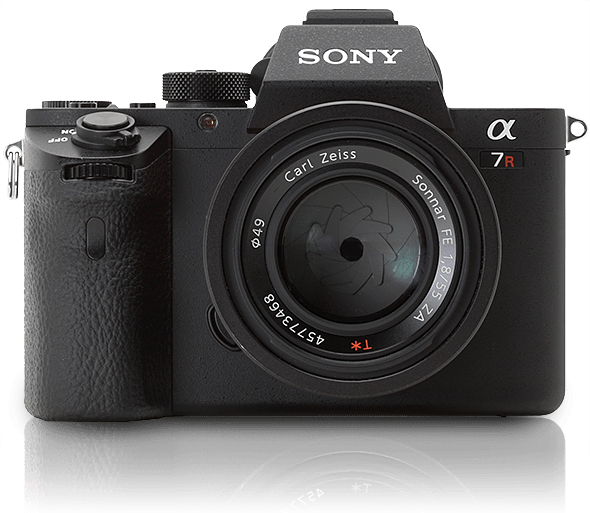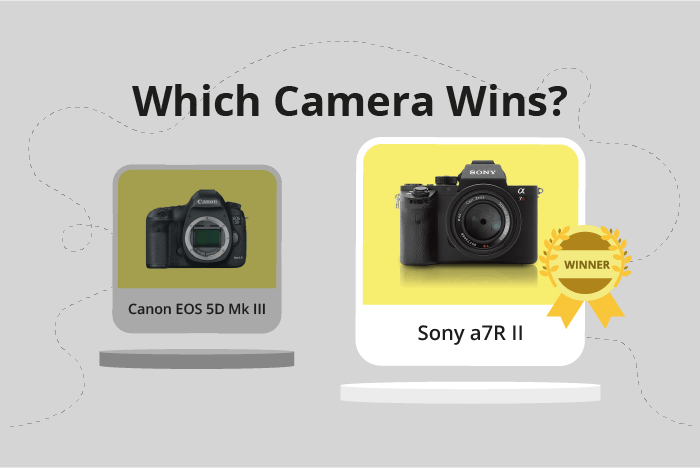Canon EOS 5D Mark III vs Sony a7R II Comparison
Canon EOS 5D Mark III

Sony a7R II

The Sony a7R II outperforms the Canon EOS 5D Mark III with a score of 70/100 compared to 65/100. Both cameras share some similarities, such as being announced in the early 2010s and having a launch price above $3000.
The Sony a7R II excels with its compact size (127 x 96 x 60mm) and lighter weight (625g), making it more portable than the Canon EOS 5D Mark III (152 x 116 x 76mm, 950g). This mirrorless camera is also more recent, having been released in 2015, three years after the Canon model.
On the other hand, the Canon EOS 5D Mark III, a DSLR, is still a reliable camera despite its age and bigger size. It may offer some advantages in specific situations or for certain users.
Considering these specifications, the Sony a7R II stands out as the better option due to its compact design and more recent release. However, the Canon EOS 5D Mark III remains a viable choice for those who prefer DSLR cameras.
Canon EOS 5D Mark III vs Sony a7R II Overview and Optics
The Sony a7R II outperforms the Canon EOS 5D Mark III in optics with a score of 81/100 compared to 67/100. Both cameras share some common specifications, such as full-frame CMOS sensors, which contribute to their high-quality image production. Additionally, they each utilize their respective lens mounts, with the Canon using the Canon EF mount and the Sony using the Sony FE mount.
The Sony a7R II surpasses the Canon EOS 5D Mark III in several aspects. With 42.4 megapixels, the Sony a7R II has almost double the resolution of the Canon’s 22.3 megapixels, resulting in more detailed and sharper images. The Sony a7R II also has a higher DXOMARK sensor score of 98, compared to the Canon’s 81, which indicates better overall image quality. Furthermore, the Sony a7R II has built-in image stabilization, a feature absent in the Canon EOS 5D Mark III. This helps reduce camera shake and contributes to sharper images, especially in low light situations.
On the other hand, the Canon EOS 5D Mark III has a faster shooting speed of 6 frames per second (fps) compared to the Sony a7R II’s 5 fps. This makes the Canon more suitable for capturing fast-moving subjects like sports and wildlife.
In terms of optics, the Sony a7R II is the superior camera due to its higher resolution, better sensor score, and image stabilization. However, the Canon EOS 5D Mark III may be more suitable for photographers who prioritize capturing fast action. Ultimately, the choice between these two cameras depends on the specific needs and preferences of the photographer.
Canon EOS 5D Mark III vs Sony a7R II Video Performance
The Canon EOS 5D Mark III and the Sony a7R II have the same video score of 56/100. Both cameras share some common video specifications, such as the lack of built-in time-lapse functionality. However, there are differences in their video capabilities that set them apart.
The Sony a7R II is superior in terms of video resolution and dimensions, as it can shoot 4K video at a maximum resolution of 3840 x 2160. This feature allows the Sony a7R II to capture more detail and produce higher quality video content compared to the Canon EOS 5D Mark III, which can only shoot Full HD videos with a maximum resolution of 1920 x 1080. The higher video resolution of the Sony a7R II makes it more suitable for professional videographers and filmmakers who require the best possible video quality.
On the other hand, the Canon EOS 5D Mark III has an advantage in terms of video frame rate, as it can shoot at a maximum of 60 frames per second (fps), compared to the Sony a7R II’s maximum of 30fps. This higher frame rate allows the Canon EOS 5D Mark III to produce smoother video footage, which is especially useful for recording fast-moving subjects or capturing slow-motion footage.
Taking these factors into account, it is clear that the Sony a7R II has the edge in video resolution and dimensions, making it more suitable for users who prioritize video quality. Meanwhile, the Canon EOS 5D Mark III’s higher frame rate makes it a better choice for those who need smoother footage, such as sports or action videographers. Ultimately, the choice between these two cameras will depend on the specific video requirements and priorities of the user.
Canon EOS 5D Mark III vs Sony a7R II Features and Benefits
The Canon EOS 5D Mark III edges out the Sony a7R II in the feature score comparison, scoring 59/100 points while the Sony a7R II scores 57/100 points. Both cameras share some common specifications, such as the absence of a touchscreen, GPS, and Bluetooth.
The Canon EOS 5D Mark III has a larger screen size of 3.2 inches compared to the Sony a7R II’s 3-inch screen. However, the Sony a7R II has a higher screen resolution of 1,228,800 dots, while the Canon EOS 5D Mark III offers 1,040,000 dots.
The Sony a7R II surpasses the Canon EOS 5D Mark III in two aspects: the presence of a flip screen and Wi-Fi connectivity. The flip screen feature provides flexibility for shooting in different angles, while Wi-Fi connectivity allows for easy transfer of images and remote camera control.
In terms of features, the Canon EOS 5D Mark III wins by a slight margin due to its larger screen size. However, the Sony a7R II offers a higher screen resolution along with the added benefits of a flip screen and Wi-Fi connectivity. These additional features can be valuable for photographers who require flexibility in shooting angles and convenient image transfer options.
Considering the feature scores and specifications, the Canon EOS 5D Mark III is slightly better in terms of overall features. However, the Sony a7R II provides useful additional features that may appeal to specific photography needs.
Canon EOS 5D Mark III vs Sony a7R II Storage and Battery
The Canon EOS 5D Mark III triumphs over the Sony a7R II in storage and battery with a score of 76/100 to 16/100. Both cameras accept SD/SDHC/SDXC memory cards, but the 5D Mark III also supports Compact Flash and UDMA cards, while the a7R II is compatible with Memory Stick Duo/Pro Duo/Pro-HG Duo cards. The 5D Mark III has a significant advantage with two memory card slots compared to the a7R II’s single slot.
In terms of battery life, the 5D Mark III outperforms the a7R II, offering 950 shots per charge compared to the a7R II’s 290 shots. Both cameras use different battery types; the 5D Mark III uses the LP-E6, and the a7R II uses the NP-FW50. Neither camera supports USB charging.
The Canon EOS 5D Mark III provides better storage options and longer battery life, making it the superior choice in this category. The Sony a7R II falls short in these aspects, but its compatibility with Memory Stick cards may be a positive feature for some users.
Canon EOS 5D Mark III vs Sony a7R II – Our Verdict
Are you still undecided about which camera is right for you? Have a look at these popular comparisons that feature the Canon EOS 5D Mark III or the Sony a7R II:

